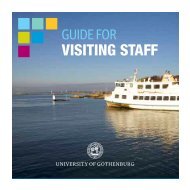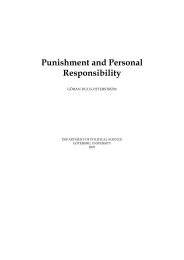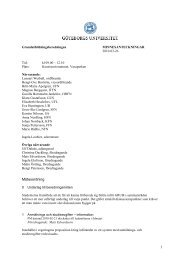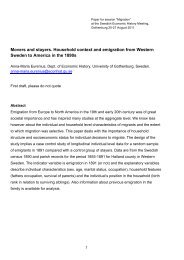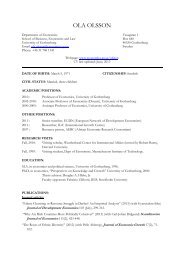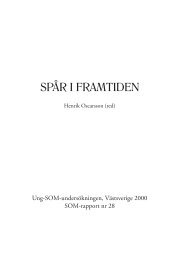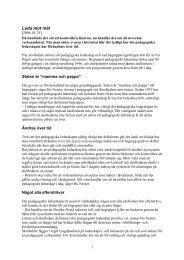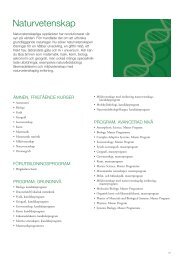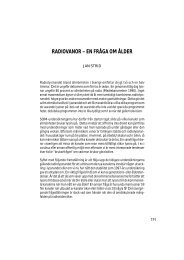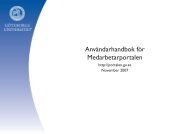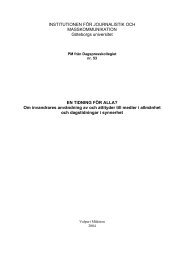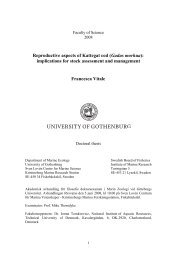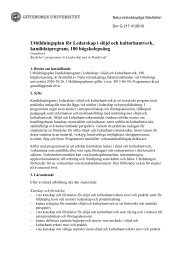development of small-scale intermodal freight transportation in a ...
development of small-scale intermodal freight transportation in a ...
development of small-scale intermodal freight transportation in a ...
Create successful ePaper yourself
Turn your PDF publications into a flip-book with our unique Google optimized e-Paper software.
prioritised their s<strong>in</strong>gle-mode operations before <strong><strong>in</strong>termodal</strong> ones. All this has created a complicated<br />
network <strong>of</strong> actors with bus<strong>in</strong>ess and ownership relations that is analysed with a historical<br />
perspective <strong>in</strong> chapter 4 <strong>of</strong> the licentiate thesis 21 .<br />
Start<strong>in</strong>g with the ambitious Leber plan and correspond<strong>in</strong>g <strong>in</strong>itiatives <strong>in</strong> other countries,<br />
politicians have frequently turned their eyes to <strong><strong>in</strong>termodal</strong> transport seek<strong>in</strong>g the solutions <strong>of</strong><br />
general problems related to road as well as rail <strong>transportation</strong>. Nevertheless, apart from the<br />
success <strong>of</strong> <strong><strong>in</strong>termodal</strong> transport <strong>in</strong> conjunction with transocean conta<strong>in</strong>er shipp<strong>in</strong>g, it is<br />
quite clear that <strong><strong>in</strong>termodal</strong> transport has not fulfilled the high expectations. Some 30 million<br />
conta<strong>in</strong>ers pass the European ports annually and 4 million <strong>of</strong> them are moved by rail to<br />
and from the h<strong>in</strong>terland. An additional 6 million ITUs move <strong>in</strong> <strong><strong>in</strong>termodal</strong> road-rail services<br />
with<strong>in</strong> Europe each year (STONE, 1997, p. 2 and 1998, p. 30). The positive th<strong>in</strong>g is<br />
that politicians do not seem to have been discouraged by the weak results.<br />
1.2.2 Current operational pr<strong>in</strong>ciples<br />
This section conta<strong>in</strong>s a description <strong>of</strong> the <strong><strong>in</strong>termodal</strong> production system with a European 22<br />
perspective, which is deeper than the <strong>in</strong>troductory description presented <strong>in</strong> section 1.1.1.<br />
The render<strong>in</strong>g is partly practical and partly theoretical <strong>in</strong> character and the outl<strong>in</strong>e is based<br />
upon the basic functions <strong>in</strong> <strong><strong>in</strong>termodal</strong> <strong>transportation</strong> systems, that is the load-carry<strong>in</strong>g<br />
function, the transport function and the transshipment function 23 . This view upon the system<br />
is further deepened <strong>in</strong> a conceptual model presented <strong>in</strong> section 4.1.3.<br />
Today, the load-carry<strong>in</strong>g function <strong>in</strong> <strong><strong>in</strong>termodal</strong> <strong>transportation</strong> systems is heavily dom<strong>in</strong>ated<br />
by ISO-conta<strong>in</strong>ers, swap bodies and semi-trailers, although <strong>small</strong>er units have been<br />
implemented on a <strong>small</strong> <strong>scale</strong> 24 .<br />
The ISO-conta<strong>in</strong>er is by far the most common ITU and the world conta<strong>in</strong>er fleet is <strong>in</strong> the<br />
range <strong>of</strong> 10 million TEUs 25 (Conta<strong>in</strong>erisation International, 1996). Due to the global<br />
agreement to encompass ISO-conta<strong>in</strong>ers <strong>in</strong> the <strong>transportation</strong> systems, such conta<strong>in</strong>ers are<br />
the obvious choice when shipp<strong>in</strong>g semi-manufactured and manufactured goods between<br />
21 For further read<strong>in</strong>g about <strong><strong>in</strong>termodal</strong> transport history, see: BUKOLD (1996), DEBOER (1992) and MULLER<br />
(1995).<br />
22 A more detailed description <strong>of</strong> the production system for Swedish domestic <strong><strong>in</strong>termodal</strong> transport is found <strong>in</strong><br />
an article appended to the licentiate thesis (WOXENIUS, 1994/a). For a Scand<strong>in</strong>avian perspective to the production<br />
system, see WOXENIUS, 1995/a. For read<strong>in</strong>g about the adm<strong>in</strong>istrative system, see WOXENIUS<br />
(1997/a) and chapter 4 <strong>in</strong> the licentiate thesis.<br />
23 In addition to these basic functions the operations obviously require a set <strong>of</strong> complement<strong>in</strong>g adm<strong>in</strong>istrative<br />
functions such as management and <strong>in</strong>formation handl<strong>in</strong>g, but these are not explicitly treated here.<br />
24 Unit load types are comprehensively described and analysed <strong>in</strong> their system context <strong>in</strong> WOXENIUS, et al.<br />
(1995/b). For a pure technical render<strong>in</strong>g, see EURET (1994).<br />
25 Twenty foot Equivalent Unit – a volume measurement used, e.g., for describ<strong>in</strong>g the capacity <strong>of</strong> conta<strong>in</strong>er<br />
ships and for conta<strong>in</strong>er transport statistics.<br />
13



